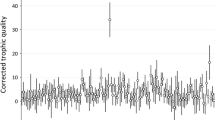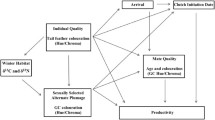Abstract
The evolutionary stability of signals varies due to interactions between sexual and natural selection. A tidal-marsh sparrow, Melospiza georgiana nigrescens, possesses darker pigmentation than an inland-marsh sparrow, M. g. georgiana. Studies of feather-degrading bacteria and convergent evolution among salt-marsh vertebrates suggest this dark coloration is due to environmental selection. Sexually dichromatic swamp sparrow crowns, however, may be additionally under sexual selection. We investigated ties between two plumage patches (rusty cap and black forehead) and two behaviors (male-male aggression and parental care) in the coastal and inland subspecies to test the effect of sexual versus natural selection on badge evolution. Across both subspecies the extent of rusty feathers in the cap patch was correlated positively with parental care and negatively with aggression, and the extent of black feathers in the forehead patch was correlated positively with aggression. Males with larger forehead patches produced more offspring along the coast, while males with larger cap patches did so inland. The date of the first nesting attempt for both subspecies correlated with cap patch extent, suggesting a similar role for female choice. Natural selection likely accounts for darker coastal females. Coastal male head color, however, is darker due to increased selection for larger forehead patches via intrasexual competition, yet it remains largely rusty due to female choice for larger cap patches. Increased sexual dichromatism among coastal plain swamp sparrows thus provides a clear example of the interplay between sexual and natural selection in subspecies divergence.








Similar content being viewed by others
References
Andersson M (1994) Sexual selection. Princeton University Press, Princeton
Badyaev AV, Hill GE (2003) Avian sexual dichromatism in relation to phylogeny and ecology. Annu Rev Ecol Evol Syst 34:27–49
Björklund M (1991) Coming of age in Fringillid birds: heterochrony in the ontogeny of secondary sexual characters. J Evol Biol 4:83–92
Bleiweiss R (1997) Covariation of sexual dichromatism and plumage colours in lekking and non-lekking birds: a comparative analysis. Evol Ecol 11:217–235
Bókony V, Liker A (2005) Melanin-based black plumage coloration is related to reproductive investment in cardueline finches. Condor 107:775–787
Bonser RHC (1995) Melanin and the abrasion resistance of feathers. Condor 97:590–591
Burns KJ (1998) A phylogenetic perspective on the evolution of sexual dichromatism in tanagers (Thraupidae): the role of female versus male plumage. Evolution 52:1219–1224
Burtt EH, Ichida JM (1999) Occurrence of feather-degrading bacilli in the plumage of birds. Auk 116:364–372
Burtt EH, Ichida JM (2004) Gloger’s rule, feather-degrading bacteria, and color variation among song sparrows. Condor 106:681–686
Duckworth RA (2006) Behavioral correlations across breeding contexts provide a mechanism for a cost of aggression. Behav Ecol 17:1011–1019
Dunn PO, Whittingham LA, Freeman-Gallant CR, DeCoste J (2008) Geographic variation in the function of ornaments in the common yellowthroat, Geothlypis trichas. J Avian Biol 39:66–72
Ellis HK (1980) Ecology and breeding biology of the swamp sparrow (Melospiza georgiana) in a southern Rhode Island peatland. MS thesis, University of Rhode Island
Endler JA (1978) A predator’s view of animal colour patterns. Evol Biol 11:319–364
Endler JA (1989) Conceptual and other problems in speciation. In: Endler JA, Otte D (eds) Speciation and its consequences. Sinauer, Sunderland
Endler JA (1992) Signals, signal conditions, and the direction of evolution. Am Nat 139:S125–S153
ESRI (2002) ArcMap 8.3. ESRI Inc., Redlands
Fretwell SD (1972) Populations in a seasonal environment. Princeton University Press, Princeton
Fretwell SD, Lucas HJ (1970) On territorial behavior and other factors influencing habitat distribution in birds. Acta Biotheor 19:16–36
Garamszegi LZ, Rosivall B, Hegyi G et al (2006) Determinants of male territorial behavior in a Hungarian collared flycatcher population: plumage traits of residents and challengers. Behav Ecol Sociobiol 60:663–671
Goldstein G, Flory KR, Browne BA et al (2004) Bacterial degradation of black and white feathers. Auk 121:656–659
Gotmark F, Post P, Olsson J et al (1997) Natural selection and sexual dimorphism: sex-biased sparrowhawk predation favours crypsis in female chaffinches. Oikos 80:540–548
Greenberg R (1988) Seasonal plumage dimorphism in the swamp sparrow. J Field Ornithol 59:149–154
Greenberg R, Droege S (1990) Adaptation to tidal marshes in breeding populations of the swamp sparrow. Condor 92:393–404
Greenberg RG, Maldonado JE (2006) Diversity and endemism in tidal marsh vertebrates. In: Droege S, Greenberg R, Maldonado J, McDonald MV (eds) Terrestrial vertebrates of tidal marshes: ecology, evolution, and conservation. Stud Avian Biol 32:32–53
Grinnell J (1913) The species of the mammalian genus Sorex of west-central California with a note on the vertebrate palustrine fauna of the region. Univ Calif Publ Zool 20:179–205
Hale RE (2008) Evidence that context-dependent mate choice for parental care mirrors benefits to offspring. Anim Behav 75:1283–1290
Irwin RE (1994) The evolution of plumage dichromatism in the new-world blackbirds: social selection on female brightness. Am Nat 144:890–907
Jawor JM, Breitwisch R (2003) Melanin ornaments, honesty, and sexual selection. Auk 120:249–265
Ketterson ED, Nolan V, Wolf L et al (1992) Testosterone and avian life histories: effects of experimentally elevated testosterone on behavior and correlates of fitness in the dark-eyed junco (Junco hyemalis). Am Nat 140:980–999
Liu IA, Lohr B, Olsen BJ, Greenberg R (2008) Macrogeographic vocal variation in subspecies of swamp sparrow (Melospiza georgiana). Condor 110(1):102–109
Mackintosh JA (2001) The antimicrobial properties of melanocytes, melanosomes and melanin and the evolution of black skin. J Theor Biol 212:128
Martin TE, Badyaev AV (1996) Sexual dichromatism in birds: importance of nest predation and nest location for females versus males. Evolution 50:2454–2460
McDonald MV, Greenberg R (1991) Nest departure calls in female songbirds. Condor 93:365–373
McGraw KJ, Safran RJ, Wakamatsu K (2005) How feather colour reflects its melanin content. Funct Ecol 19:816–821
Missowelt M, Engqvist L, Lubjuhn T, Sauer KP (2008) Nuptial feeding in the scorpionfly, Panorpa vulgaris: maintenance of genetic variance in sexual advertisement through dependence on condition-influencing traits. Evol Ecol 22(5):689–699
Olsen BJ (2007) Life history divergence and tidal salt marsh adaptations of the coastal plain swamp sparrow. Ph.D. dissertation, Department of Biological Sciences, Virginia Polytechnic Institute and State University, Blacksburg, VA
Olsen BJ, Greenberg R, Fleischer RC, Walters JR (2008a) Extrapair paternity in the swamp sparrow, Melospiza georgiana: male access or female preference? Behav Ecol Sociobiol 63(2):285–294
Olsen BJ, Felch J, Greenberg R, Walters JR (2008b) Causes of reduced clutch size in a tidal marsh endemic. Oecologia 15(3):421–435
Peele AM, Burtt EH, Schroeder MR, Greenberg R (2009) Dark color of the coastal plain swamp sparrow (Melospiza georgiana nigrescens) may be an evolutionary response to occurrence and abundance of salt-tolerant, feather-degrading bacilli in its plumage. Auk 126(3):531–535
Pyle P, Howell NG (1997) Identification guide to North American birds: part I. Slate Creek Press, Bolinas
Qvarnström A (2001) Context-dependent genetic benefits from mate choice. Trends Ecol Evol 16(1):5–7
Reinert SE, Golet FC (1979) Breeding ecology of the swamp sparrow in a southern Rhode Island peatland. Trans Northeast Sect Wildl Soc 1986:1–13
Rohwer S (1975) Social significance of avian winter plumage variability. Evolution 29:593–610
Roulin A (2007) Melanin pigmentation negatively correlates with plumage preening effort in barn owls. Funct Ecol 21(2):264–271
Sætre GP, Dale S, Slagsvold T (1994) Female pied flycatchers prefer brightly colored males. Anim Behav 48(6):1407–1416
SAS Institute (2005) The SAS system for windows: Ver. 9.1. The SAS Institute Inc., Cary
Schols P (2001) Carnoy 2.0. Lab of plant systematics, K.U. Leuven: http://bio.kuleuven.be/sys/carnoy/
Searcy WA, Nowicki S, Hughes M (1997) The response of male and female song sparrows to geographic variation in song. Condor 99:651–657
Senar JC (1999) Plumage coloration as a signal of social status. Proc Int Ornithol Congr 22:1669–1686
Siefferman L, Hill GE (2003) Structural and melanin coloration indicate parental effort and reproductive success in male eastern bluebirds. Behav Ecol 14:855–861
Stefanski RA, Falls JB (1972) A study of distress calls of song, swamp, and white-throated sparrows (Aves: Fringillidae): I. Intraspecific responses and functions. Can J Zool 50:1501–1512
Stoehr AM, Hill GE (2000) Testosterone and the allocation of reproductive effort in male house finches (Carpodacus mexicanus). Behav Ecol Sociobiol 48:407–411
Von Bloeker JCJ (1932) Three new mammal species from salt marsh areas in southern California. Proc Biol Soc Wash 45:131–138
Wallace AR (1889) Darwinism. Macmillan, London
Wingfield JC, Ball GF, Dufty AM et al (1987) Testosterone and aggression in birds. Am Sci 75:602–608
Acknowledgments
We would like to thank the Delaware Division of Fish and Wildlife, H. Ternent of Lonaconing, Maryland, USA, the Western Maryland 4-H Education Center, and the Nature Conservancy for access to and use of our study sites. Funding was supplied by grants from the Bailey Fund at Virginia Tech, the Smithsonian Institution’s Abbot Fund, the Delaware Division of Fish and Wildlife, the Maryland Ornithological Society, the Washington Biologists’ Field Club, the Washington Group of the Explorer’s Club, the Eastern Bird Banding Association, Virginia Tech’s Graduate Research Development Program, and Smithsonian Institution Graduate and Pre-doctoral Fellowships. Many thanks to K. Kalasz, J. Wang, M. Powell, K. Murabito, J. Kolts, K. Callaway, A. Wessel, J. Adamson, B. Augustine, B. Beas, K. Heyden, and A. Roadman for assistance in the field and lab. Thanks to B. Ballentine for providing audio recordings of M. g. georgiana song. This research complied with state and federal law. Bird capture and handling were conducted under scientific collection permits from the states of Delaware and Maryland and federal banding permit number 22665. Impacts on animal welfare were approved by the Conservation and Research Center Institutional Animal Care and Use Committee of the Smithsonian National Zoological Park under proposal #04-10.
Author information
Authors and Affiliations
Corresponding author
Rights and permissions
About this article
Cite this article
Olsen, B.J., Greenberg, R., Liu, I.A. et al. Interactions between sexual and natural selection on the evolution of a plumage badge. Evol Ecol 24, 731–748 (2010). https://doi.org/10.1007/s10682-009-9330-4
Received:
Accepted:
Published:
Issue Date:
DOI: https://doi.org/10.1007/s10682-009-9330-4




